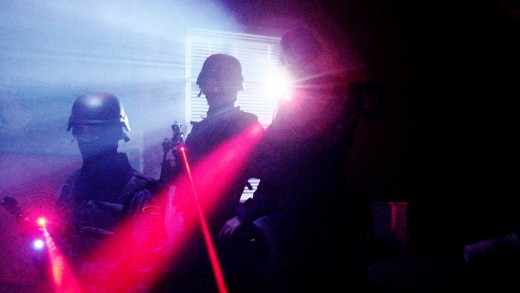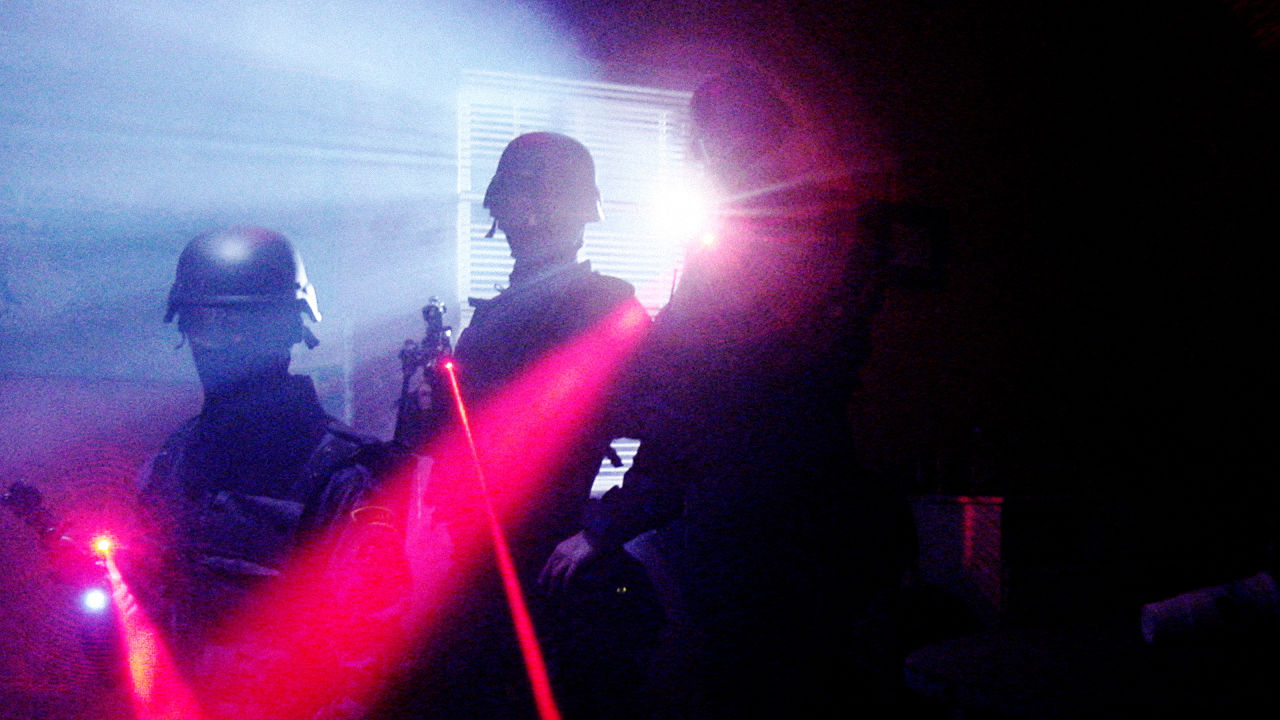The World’s Unfunniest Prank Is Terrifying Gamers And Costing Police A Fortune
Gamers are calling in fake emergencies and sending real SWAT teams to each others’ homes.
A few weeks ago, a 17-year-old sat in a provincial courtroom in south British Columbia “wearing a sweatsuit, no shoes, and shackles on his ankles,” according to the local Tri-City News, and pleaded guilty to a dozen charges of extortion, public mischief, and criminal harassment.
By and large, his victims were gamers—mostly female—whom the teen had met while playing the popular online computer game League of Legends. Time and again, he’d attempt to connect with fellow players—through the game, but also outside of it, via instant messenger and social media. When he was rejected, he’d start tormenting people, shutting down their Internet access, posting their private info online, messing with their finances, and, maybe worst of all, alerting authorities to made-up dangerous incidents at their residence meant to result in an armed response.

This last behavior is known as “swatting,” after the SWAT teams that are forced to respond to these invented emergencies. One woman, a student at the University of Arizona in Tucson, was forced to withdraw from school after the boy repeatedly went after both her and her parents. At one point, the teen (whose name was kept out of reports of the trial due to his status as a minor) had police officers sent to her and her parents’ homes simultaneously by pretending to be the woman’s brother and claiming that he had shot their mother and father with an AR15 rifle and was sitting on a cache of bombs, according to the News.
Despite his relentlessness, the boy may have never been stopped were it not for his tendency to boast about his crimes publicly, sometimes even live-streaming himself as he terrorized his targets. Last November, another teen in Newport Beach, California, who’d seen his videos, called police after turning down an invitation from him to connect via Twitter, saying that she believed she was about to be his next victim; sure enough, the station soon received a call reporting an armed hostage situation at her address.
In all, the teen pled guilty to a staggering 23 swatting-related charges, showing no signs of contrition, according to news reports. Instead he simply smirked and flipped his hair, drumming his fingers on the defense table as the hearing wound down.
First used by the FBI in 2008, swatting refers to the act of calling in a fake report of a violent crime at a location—be it a home, school, or other public venue—in the hope of drawing an armed response from police, or, better yet, the SWAT team. While the most high-profile examples have involved celebrities like Tom Cruise, former Georgia Senator Saxby Chambliss, and Lil Wayne—whose Miami mansion was swatted in March while the rapper was busy recording at a studio miles away—these headline-grabbing names are just a small portion of those victimized each year. Although there are no hard statistics, a 2013 FBI report estimated the number of swatting hoaxes called in each year to be in the hundreds.
Those most likely to be targeted are a new type of celebrity: the Internet famous, who’ve captured the attention of thousands—sometimes millions—by broadcasting their lives and hobbies on sites like YouTube, and especially Twitch.TV, the main live-streaming site for gamers. Log in to Twitch at any time of the day, and you’ll see hundreds of thousands of viewers watching other people play games like League of Legends, Hearthstone: Legends of Warcraft, and Minecraft. It’s the reason why Amazon bought the site for $970 million last year. According to The Wall Street Journal, Twitch.TV is the fourth-largest source of Internet traffic in the U.S., trailing only Netflix, Google, and Apple.
In its brief lifespan, video-game live streaming has morphed from fanboy entertainment medium to social forum, where gamers of all stripes can congregate to talk about their shared passion. But during this astonishingly quick evolution, something has gone awry. The types of gamers who used to mess with others’ games and bully players, who until now had been confined to obscure game servers and communities, have found a larger-than-ever venue for their cruelty. Live streaming has given swatters the opportunity to gleefully watch as they publicly humiliate and frighten their victim in real time.
Nearly 60,000 people, for example, were watching a stream of Air Force vet Joshua Peters playing Runescape just after midnight on February 4, when his family’s home in St. Cloud, Minnesota, was swatted. In a video of the incident, Peters, who streams under the name Koopatroopa787, can be seen removing his headphones after his mother knocks on the door to tell him that the police had arrived. The understandably confused gamer pauses his playthrough, but not the stream, to investigate.
When he finally returns to his seat, the 28-year-old breaks into tears, describing what has just happened. “I see you posting my address,” he says. “I had police point a gun at my little brothers because of you. They could have been shot. They could have died because you chose to swat my stream. I don’t give a shit about what you have against me, or what I did to you. For that, I am at a loss for words. Your gripe is with me, so let it be with me, and do not involve my family in any way, shape, or form with this. They don’t deserve that.”
The New York Times picked up on Peters’s story in its March 20 story on swatting in the gamer community. Live streaming’s popularity has created an “occupational hazard” for gamers, the paper reported: “Build a following by streaming—and make yourself a potential target.”
To a swatter, someone’s high follower count is that much more reason to go after them. They get the chance to embarrass a “celebrity,” while an audience that they’ve hijacked watches on.
While it’s considered a computer crime, swatting isn’t hacking. All a swatter needs is an address and a way of masking his phone number so authorities have no one to trace the call back to.
As far as obtaining that information, “the exploits are anywhere you give your money,” a 16-year-old who posts on Reddit under the name ZeroExFF and claims to have been involved in a number of swattings told Kotaku in February. If you can get in touch with a customer service representative—be it at an Internet service provider or Amazon—and convince them that you are your target, you can get hold of their physical address by “double checking” their info.
For the call itself, some swatters use text-to-voice services meant for the deaf to mask their phone numbers, which don’t track users’ personal information because of privacy laws. Others buy phone number-masking software. Still others rely on caller ID-scrambling apps for their smartphones.
Finally, a swatter must convince police to take the call seriously. Police respond to calls every hour of every day, but a swatter must convince them that this is no ordinary crime. Police must believe that the situation they’re responding to is an emergency requiring an armed response from a significant number of officers, not just one patrol car.
ZeroExFF is on the forefront of another disturbing development in the realm of swatting: swatters for hire, who charge people a fee in exchange for collecting the information they’ll need to call a SWAT team on their selected target. For a nominal fee, he’s providing would-be-swatters with all the information they need. “You can make money off it, because they don’t know they can just go and do it themselves,” he told told Kotaku. “You can call any ISP left and right for $10 each. You can give them the information.”
While swatting has become a problem for communities all across the U.S., no state has seen more of it in 2015 than New Jersey. More than two dozen hoaxes have been called in there since the beginning of the year.
Just in the last month, the city of Princeton has seen five swatting incidents—four of them directed at schools, another at a home. The string of swattings began at 9:45 a.m. on Tuesday, April 28, when Riverside Elementary School received a prerecorded call in which a woman, who claimed to be armed, threatened the students. Exactly two weeks later, on Tuesday, May 12, John Witherspoon Middle School, received an identical message. In both cases, the threat was investigated and deemed to be fake, but police patrols were increased at all of the city’s public and private schools. A week later, three swatting calls were made over just two days, beginning at 9:45 a.m. on Tuesday, May 19, when a prerecorded call came in to Johnson Park Elementary School, and ending at 9:37 a.m. on Thursday, May 21, when another call “similar in nature” was made against Princeton High School.
While it became clear over time that the calls were related, authorities had no choice but to give each one a full investigation. Charles Webster, spokesman for the Monmouth County Prosecutor’s Office, points out that there is no other choice. “It costs tens of thousands of dollars to find out that it was a hoax,” said Webster, in an interview with NJ.com. “But if we start treating every incident as a hoax, that’s when you have one that turns out to be real.”
Easy as it may be to perpetrate, the penalties for swatting can be harsh. In 2009, then 19-year-old Matthew Weigman was sentenced to 11 years in federal prison related to a swatting offences going back five years. And just this January, Jason Allen Neff was sentenced to five years in prison and ordered to pay $79,440 in restitution for his part in a swatting group.
A number of states have pushed for legislation to make those penalties harsher still. Sponsored by state Assemblyman Paul Moriarty, a bill currently making its way through the New Jersey legislature would have swatters face a prison term of five to 10 years, a fine of up to $150,000, or both. Given how young and immature the majority of swatters seem to be, such measures could be considered draconian. Still, deterrence may be these communities’ best hope of relieving the strain repeated swatting incidents have placed on their resources.
In a place like Princeton, with a population of less than 30,000, the majority of the area’s emergency infrastructure will be dedicated to responding to a fake call. While this is going on, the police radio is tied up, patrol cars speed to the scene, roadways are blocked, residents are evacuated, and every other non-emergency call is temporarily pushed aside. The actual monetary cost can run into thousands of dollars per hour—no small sum, especially in areas where budgets are tight.
And that’s before you take into account the heightened sense of awareness everyone involved with a swatting, from the responders to the victims, must deal with. By definition, victims are completely unprepared for the heavily armed officers who are about to burst into their home. There has yet to be anyone seriously hurt in the course of a swatting hoax, but there have been close calls. A recent episode of the podcast Reply All recounted a swatting in North Carolina where the victim met police with a shotgun. The 2013 FBI report noted that several victims were so shocked, they suffered mild heart attacks.
“This has happened around the state—north and south, at businesses, at schools, and at homes like mine,” Moriarty said when he introduced the New Jersey anti-swatting bill. “We need to send a clear message that when we find you, you will go to jail.” Of course, shortly afterwards, his home was swatted.
“In some ways, swatting is a great prank: it flummoxes the victim while simultaneously tweaking authority, and also there’s a chance it might get on the news,” Slate’s Justin Peters wrote in 2013. But as he goes on to point out, that’s before you take into account the costs and risks of swatting—something many of those caught committing the crime have clearly not done.
Those who still need convincing should consider what happened at Digital Press Videogames in Clifton, New Jersey, on March 28. Just after 7 p.m. that evening, police received a call claiming that “men with shotguns” had taken a number of hostages, the Cliff View Pilot reported. The Passaic County Sheriff’s Office immediately dispatched a SWAT team and hostage negotiators to the scene. Meanwhile, at the store, around 40 gamers had gathered for the monthly meeting of NAVA (North Atlantic Videogame Aficionados). The normal video game-discussions and trading came to an end at 8 p.m. when the group realized that police had started to gather in the area, something they assumed meant something serious was happening nearby.
An hour later, things took a turn for the sinister when the store received a call from someone claiming to be from the local fire department. The caller asked those in the store to close its blinds, which they did, but then asked that someone open the door and call out, “Clear the area, somebody has a gun,” according to Kotaku. Realizing that all was not right, the store owner hung up on the caller and immediately contacted police.
It was then that officers on the scene realized that what they thought was an emergency probably wasn’t—but still, they were forced to investigate. “Protocol still dictated that [police] needed to enter the building to assess the threat in full riot gear with assault weapons,” the store’s web administrator told Kotaku, “address each of us individually, take each person out individually, handcuff each of us, and sit us down in the business next door to Digital Press for approximately 20 minutes where we waited for them to clear the store, do a sweep, confirm that it was a hoax, and then remove our cuffs and take our personal information down.”
This was more than just a prank. This was a situation in which the swatter or swatters had gone out of their way to ratchet up the danger for all involved. Had those at Digital Press followed the caller’s instructions and announced that there was a gun on the premises, the standoff might have turned dangerous—even deadly. Instead, everyone left annoyed, but alive.
Fast Company , Read Full Story
(201)














